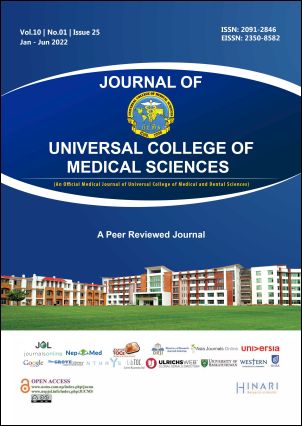The Outcome of Trauma Patients in the Mixed Semi-closed Intensive Care Unit
DOI:
https://doi.org/10.3126/jucms.v10i01.47215Keywords:
APACHE II, Injury severity score, Intensive care units, SOFA, TraumaAbstract
INTRODUCTION
Nepal due to its geographical condition, inadequate resuscitation on time, and lack of full-time intensivist in a trauma team is a cause of trauma-related morbidity and mortality.
MATERIAL AND METHODS
It was a prospective, descriptive observational cross-sectional study in a level three intensive care unit of National Medical College for six month. All patients >18 years with a history of road traffic accidents, falls, drowning, physical assaults, and self-inflicted violence admitted to the mixed intensive care unit of a tertiary care hospital were included in this study.
RESULTS
One hundred and ninety-one patients were included in this study. 152(79.5%) were males and 39(20.4%) were females. A road traffic accident was the most common mode of injury in 166(86.9%) patients. 178(93.1%) patients survived and went home, 10(5.3%) expired, 2(1%) left the hospital against medical advice (LAMA) and 1(0.5%) gave do not resuscitate orders (DNR). The mean days on the mechanical ventilator was 3.39±2.57 days. Mortality in an intubated patient was 8.6%. Mean LOS in the ICU was 4.28±4.12 days. SOFA and APACHE II scores were a good predictor of outcome, with the SOFA score being the most effective Injury severity score predicted mortality with a sensitivity of 88.9%, a specificity of 22%, with an AUROC curve of 0.543±0.092 with cut off score of 5.5.
CONCLUSION
Raising public awareness, and strictly following the traffic rules can help in reducing the incidence of trauma. Trauma team consisting of full-time intensivists should be established to decrease the mortality in the intensive care unit.
Downloads
Downloads
Published
How to Cite
Issue
Section
License
Copyright (c) 2022 Journal of Universal College of Medical Sciences

This work is licensed under a Creative Commons Attribution-NonCommercial 4.0 International License.
Authors have to give the following undertakings along with their article:
- I/we declare that this article is original and has not been submitted to another journal for publication.
- I/we declare that I/we surrender all the rights to the editor of the journal and if published will be the property of the journal and we will not publish it anywhere else, in full or part, without the permission of the Chief Editor.
- Institutional ethical and research committee clearance certificate from the institution where work/research was done, is required to be submitted.
- Articles in the Journal are Open Access articles published under the Creative Commons CC BY-NC License (https://creativecommons.org/licenses/by-nc/4.0/)
- This license permits use, distribution and reproduction in any medium, provided the original work is properly cited, and it is not used for commercial purposes.




